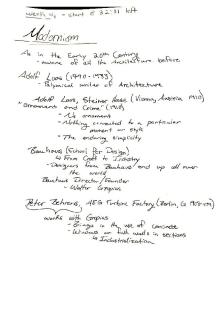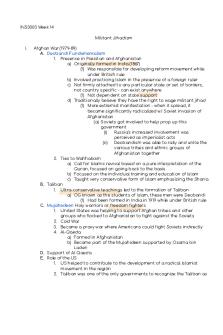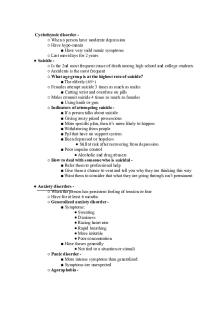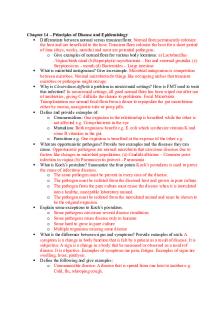Disease Processes Week 14 PDF

| Title | Disease Processes Week 14 |
|---|---|
| Author | BoB BoBington |
| Course | Care Management 2 |
| Institution | Keiser University |
| Pages | 6 |
| File Size | 170.6 KB |
| File Type | |
| Total Downloads | 12 |
| Total Views | 136 |
Summary
Disease Process...
Description
Disease Process Osteoporosis 1
Pathophysiology
Osteoporosis is a chronic disease of cellular regulation in which bone loss causes significant decreased density and possible fracture. It is often referred to as a silent disease or silent thief because the first sign of the disease in most people follows some kind of fracture. The spine, hip, and wrist are most often at risk, although any bone can be fractured.
2
Etiology
Primary osteoporosis is caused by a combination of genetic, lifestyle, and environmental factors. The relationship of osteoporosis to nutrition is well established. Excessive caffeine in the diet can cause calcium loss in the urine. A diet lacking enough calcium and vitamin D stimulates the parathyroid gland to produce parathyroid hormone. PTH triggers the release of calcium from the bone matrix. Activated vitamin D is needed for calcium uptake in the body. Malabsorption of nutrients in the small intestines also contributes to low serum calcium levels. Institutionalized or homebound patients who are not exposed to sunlight may be at a higher risk because they do not receive adequate vitamin D for the metabolism of calcium. Calcium loss occurs at a more rapid rate when phosphorus intake is high. People who drink large amounts of carbonated beverages each day are at high risk for calcium loss and subsequent osteoporosis, regardless of age. Protein deficiency may also affect cellular regulation 50% of serum calcium is protein bound, protein is needed to use calcium. Excessive protein intake may increase calcium loss in the urine. Diets such as the Atkin’s diet, may inadvertently force participants to consume too much protein to replace other food not allowed. Excessive alcohol and tobacco use are other risk factors for osteoporosis. Although the exact mechanisms are not known, these substances promote acidosis, which in turn increases bone loss. Alcohol has a direct toxic effect on bone tissue, resulting in decreased bone formation and increased bone resorption. For people who have excessive alcohol intake, alcohol calories may decrease hunger and the need to take in adequate amounts of nutrients.
3
Epidemiology
Osteoporosis is a potential health problem for more than 44 million Americans. About 1o million people in the United States have the disease, and about 34 million people 50 years of age and older have osteopenia and are at risk for development of osteoporosis. As baby boomers age, these numbers are expected to increase dramatically. Euro-American postmenopausal women have a 50% chance of having an osteoporotic related fracture in their lifetime. A woman who experiences a hip fracture has a 4 times greater risk for a second fracture. The mortality rate of for older patients with hip fractures is very high, especially within the first 6 to 12 months, and the debilitating effects can be devastating.
4
Clinical Manifestations
Movement restrictions and spinal deformity may result in constipation, abdominal distension, reflux esophagitis, and respiratory compromise in many cases
5
Diagnosis
A complete health history with assessment of risk factors is important in the prevention, early detection, and treatment of osteoporosis. Include a fall risk assessment in the health history. When performing a musculoskeletal assessment, inspect the vertebral column. The classic “dowager’s hump,” or kyphosis of the dorsal spine is often present. The patient may state that they have gotten up to 2 to 3 inches shorter. The patient may have back pain, which often occurs after lifting, bending, or stooping. The pain may be sharp and acute in onset. Pain is worse with activity and is relieved by rest Back pain accompanied by tenderness and voluntary restriction of spinal movement suggests one or more compression vertebral fractures. Ask the patient to locate all of the areas that are painful and observe for signs and symptoms of fractures, such as swelling and malalignment No definitive laboratory tests confirm a diagnosis of osteoporosis, although a number of bone turnover markers can provide information about bone resorption and formation activity. Conventional x-rays of the spine and long bones show decreased bone density, but only after a large amount of bone loss has occurred. Fractures can also be seen on x-ray.
6
Treatments
Because the patient is predisposed to fractures, nutritional therapy, exercise, lifestyle changes, and drug therapy are used to slow bone resorption and form new bone tissue. Self-management education can help prevent osteoporosis.
7
Nursing Considerations
Fractures as a result of osteoporosis and falling can decrease a patient’s mobility and quality of life. People with osteoporosis are at an increased risk for fracture if a fall occurs.
8
Patient Teaching
Young women need to be aware of appropriate health and lifestyle practices that can prevent this potentially disabling disease.
Teach patients who do not include enough dietary calcium which foods to eat, such as dairy products and dark green leafy vegetables. Teach patients to read food labels for sources of calcium content. Explain the importance of sun exposure and adequate vitamin D in the diet. Teach individuals at high risk for bone loss the importance of smoking cessation, weight loss, and excessive alcohol avoidance. Teach patients to limit the number of carbonated beverages consumed daily. Teach high-risk people to avoid activities that cause jarring, such as horseback riding and jogging, to prevent potential vertebral compression fractures.
Disease ProcessPaget’s Disease 1
Pathophysiology
Paget’s disease of the bone is a skeletal disorder resulting from excessive osteoclastic activity, affecting the long bones, pelvis, lumbar vertebrae, and the skull predominantly
2
Etiology
Paget’s disease may be caused by infection from blood-borne viruses. After acute viremia, osteoclasts become chronically infected, stimulating osteoclastic proliferation.
3
Epidemiology
The cause of the disease is unknown, although there is evidence of familial tendency. It is more common in men than in women. It is rare before the age of 40.
4
Clinical Manifestations
Patients are generally asymptomatic. The most common symptoms are pain and predisposition to fracture. Pagetic lesions can lead to:
5
Diagnosis
-
OA, joint destruction, and spinal deformity. Decrease in hearing, tinnitus, and vertigo as a result of skull abnormality Waddling gait due to abnormality of pelvis Radiculopathy and nerve palsies due to effects from the vertebral column
-
Elevated serum alkaline phosphatase and urine hydroxyproline
-
6
Treatments
Serum calcium, phosphorus, and albumin levels usually normal Generally confirmed with radiologic examinations showing characteristic abnormalities Bone scans can evaluate rapid bone turnover Bone biopsy to differentiate from osteomyelitis or bone tumour.
There is no treatment for asymptomatic Paget’s. Pain management with NSAIDs, aspirin Medication – Calcitonin is the main medication used to suppress bone turnover, reduce pain, and prevent progression
7
Nursing Considerations
8
Patient Teaching
-
Administer and teach self-administration of analgesics Avoid sedation due to opioids, which may increase risk of falls. Establish exercise protocols through a PT consult to maintain physical abilities and prevent falls Teach safe transferring and make sure patient can alert nurses if he or she needs help
Teach safety measures in the home – removal of loose rugs and obstacles to prevent falls, good lighting Provide education about the disease process and medication treatment Make sure that patient knows how to use mobility aids Encourage follow-up for periodic hearing tests and bloodwork.
Disease Process Muscular Dystrophy 1
Pathophysiology
Muscular dystrophy refers to a group of genetically determined, progressive, degenerative myopathies affecting a variety of muscle groups – most patients are children.
2
Etiology
Muscular dystrophy may be X-linked, autosomal dominant, or recessive. A genetic coding defect causes abnormal muscle development and function – mutations in the dystrophin gene. There is a loss of skeletal muscle fibres, but no associated structural anomalies in peripheral nerves or spinal cord. A marked reduction of dystrophin, a protein vital to muscle function. The amount of dystrophin varies with the type of MD.
3
Epidemiology
The common Muscular dystrophies are Duchenne’s MD, affecting 1 in 3,500 live-born males, and Becker’s MD, affecting 1 in 30,000 live-born males. Most with Duchenne’s MD rarely survive beyond ages 20-25.
4
Clinical Manifestations
Progressive muscular weakness
5
Diagnosis
Gower’s sign is a hallmark feature of Duchenne’s MD, characterized by a child’s difficulty rising from the floor. Heart muscle weakens and tachycardia develops Respiratory muscles weaken, causing ineffective cough and frequent infections
Nerve conduction test and electromyography show abnormalities Serum creatinine kinase – elevated Deoxyribonucleic acid analysis of blood Muscle biopsy may provide definitive diagnosis
6
Treatments
Goals of treatment are directed towards maintaining mobility, quality of life, and prevention of complications. -
7
Nursing Considerations
Medications to control symptoms, such as anti-arrhythmic and bronchodilators Promotion of ambulation with appropriate aid after loss of ability to walk Provision of spinal orthotic support Surgical tendon releasing to treat contractures Physical therapy, such as passive stretching, to preserve function Vigorous respiratory therapy, such as chest percussion, inspirometry, and assisted cough Pulmonary function monitoring
Encourage upright positioning to provide for maximum chest excursion Encourage energy-conservation techniques and avoidance of exertion Refer to physical therapy for stretching and strengthening exercises to optimize remaining motor function Perform ROM exercises to preserve mobility and prevent atrophy Monitor vital signs, cardiac rhythm, and signs of heart failure, such as edema, adventitious breath sounds, and weight gain Assess cranial nerve function for swallowing and chewing
8
Patient Teaching
-
Offer genetic counseling, if indicated, to determine options of family planning Instruct the patient and family in ROM exercises, pulmonary care, and methods of transfer and locomotion Stress the importance of fluids to decrease risk of urinary/pulmonary infection and minimize constipation
References Ignatavicius, D. D., Workman, L. M., & Rebar, C. R. (2018). care, Medical Surgical Nursing: Concepts for interprofessional collaborative (Vol. 1). St. Louis, Missouri, USA: Elsevier. Porth, C. M. (2015). Essentials of Pathophysiology. Philadelphia, PA, USA: Wolters Kluwer Health....
Similar Free PDFs

Disease Processes Week 14
- 6 Pages

Week 14 Lab Worksheet
- 2 Pages

Week 14 GST - GST
- 4 Pages

Week 14 Assignment
- 3 Pages

Week 14 Notes
- 9 Pages

TASK WEEK 14
- 3 Pages

INS3003 Week 14 Notes
- 5 Pages

Zoo biology week 14
- 5 Pages

Week 14 Reading Response
- 1 Pages

Week 14 Lab Worksheet
- 2 Pages

WEEK 14-HW-Ch 18
- 6 Pages

M&M - Week 14 Notes
- 1 Pages

Week 14 Genetic & Mutations notes
- 48 Pages
Popular Institutions
- Tinajero National High School - Annex
- Politeknik Caltex Riau
- Yokohama City University
- SGT University
- University of Al-Qadisiyah
- Divine Word College of Vigan
- Techniek College Rotterdam
- Universidade de Santiago
- Universiti Teknologi MARA Cawangan Johor Kampus Pasir Gudang
- Poltekkes Kemenkes Yogyakarta
- Baguio City National High School
- Colegio san marcos
- preparatoria uno
- Centro de Bachillerato Tecnológico Industrial y de Servicios No. 107
- Dalian Maritime University
- Quang Trung Secondary School
- Colegio Tecnológico en Informática
- Corporación Regional de Educación Superior
- Grupo CEDVA
- Dar Al Uloom University
- Centro de Estudios Preuniversitarios de la Universidad Nacional de Ingeniería
- 上智大学
- Aakash International School, Nuna Majara
- San Felipe Neri Catholic School
- Kang Chiao International School - New Taipei City
- Misamis Occidental National High School
- Institución Educativa Escuela Normal Juan Ladrilleros
- Kolehiyo ng Pantukan
- Batanes State College
- Instituto Continental
- Sekolah Menengah Kejuruan Kesehatan Kaltara (Tarakan)
- Colegio de La Inmaculada Concepcion - Cebu


